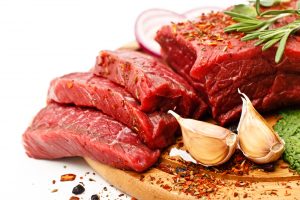
Clients love their meat, but it is expensive for an aged care budget…
In today’s modern world, our view of what a portion or serving size should be has become warped. We want a nice big, juicy steak because that represents value for money, as well as what we consider a decent meal. The Australian Nutrition Guidelines recommended portion size for protein is either:
- 90 – 100g of raw meat
- Small can of fish
- 1 cup of cooked legumes
- 170g of tofu
Now, on many remote Aboriginal communities, the preference will always be meat, although coastal communities do love their fish. I don’t think adding tofu to the menu would go down too well with the clients, plus the cost would be prohibitive anyway!
In the remote aged care services I have worked in, we were always trying to provide our clients with the best service. That meant we endeavoured to produce tasty, as well as healthy meals. Of course, our clients always wanted more meat in their meals. In most Central Australian communities, fish was generally not well received, except perhaps as a tuna mornay, and we couldn’t cook that too often or there would be complaints.
As an ingredient though, lean meat is expensive. So how did we keep within budget, ensure the food we were cooking was healthy and provide our clients with food that they enjoyed eating? Here are some of our trade secrets:
- Lentils – we would soak a bag of brown lentils overnight and add these to a stew. By the time the stew had cooked through, the lentils had broken up and became part of the gravy. Canned lentils are also available if soaking time is a problem. Other pulses that can be used are green split peas and red lentils both of which break down relatively quickly;
- Grated vegetables – grating carrots and adding them to the pan after the meat has been browned when making Spaghetti Bolognese adds bulk and flavour. Again, by the time the meat has cooked out, the carrot is no longer visible as a separate vegetable;
- Finely chopped or pureed vegetables – we found that the finely chopped vegetables (a food processor is great for this) were excellent for adding bulk and keeping clients happy, as long as they were cooked out and softened sufficiently so they were easily eaten by those with dental problems, or left over vegetables can be pureed and added to stews;
- Canned beans – these were often put through the blender first to break up into smaller pieces. A couple of tins of red kidney beans, broken up and mixed through a stew become indistinguishable from the meat pieces. Chickpeas or lima beans are good when mixed through chicken mince.
- Oats, rice and other grains – adding a cup of rolled oats to a stew increases the dietary fibre in the stew and thickens it at the same time. Buckwheat grits are an alternative if anyone has a gluten intolerance. We also bulked out meatloaf with cooked rice along with grated vegetables;
- Potatoes – both normal and sweet potatoes (yams) can bulk out a meal, and along with other vegetables added to a stew were always well received. Potatoes can also be mashed and placed on top of a meat and vegetable meal such as Shepherd’s Pie. Clients often enjoyed the creamy mashed potatoes and the meat was supplemented with a simple packet of mixed vegetables providing bulk and fibre to the meal.
Keep these 6 tips in mind next time you have to bulk up your client meals!
- What’s the deal with Care Coordination? - May 21, 2024
- When Cancer Gets Up Close and Personal… - May 14, 2024
- Aged Care Packages – what’s in the box? - February 16, 2024



